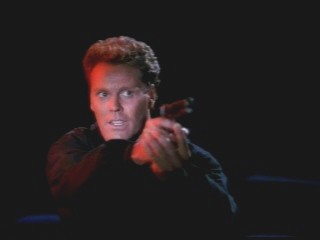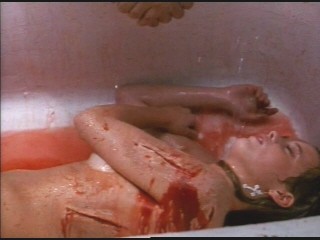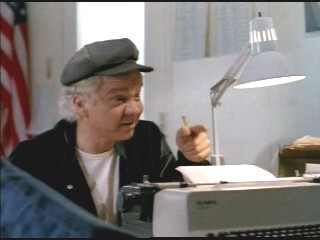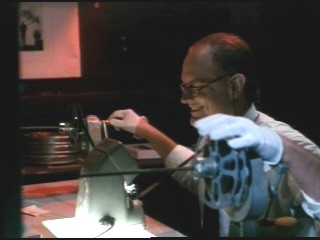
|
|
|
|
|
|
|
|
|
|
|
|
|
(1991) Director: Wings
Hauser
I think all of us are fighting a private war of one kind or another. In my case, the war I am fighting is against ignorance. To be more precise, for some time now I have been struggling to enlighten the general public about the (sometimes) brilliance of movies made by PM Entertainment. It hasn't been an easy battle; even my expressed enthusiasm for movies like The Sweeper and Last Man Standing haven't seem to budged people that much. So even though I indicated that the next PM movie I would review would be Rage, I've decided to change tactics in part by reviewing The Art Of Dying next. That's because there is something different about this PM movie from many others, something that I know will instantly transfix many people out there. That fact being that it's available on DVD. Oooh, DVD, DVD! Look how shiny it is! Can't you just smell that polycarbonate and aluminium? Aren't you just drooling over the idea of chapter stops and trailers, the latter in this case being a whopping 48+ minutes of trailers for this and other PM movies? Not to mention much better picture and sound quality than those oh so filthy VHS tapes? That's it, come on, come on boy! Come get it! Okay, maybe all of that was a low blow, considering how many people are fanatical about DVD and will watch anything if available on that format... but as you no doubt know, war is a dirty game, and if such dirty tactics are necessary to win people over for the greater good, so be it. Getting back on topic, The Art Of Dying
has some other things differentiating it from what may be considered a
typical PM movie. It was made But The Art Of Dying manages to be much different from the usual PM movie than just with it having much less action. For one thing, instead of Merhi, Pepin, or one of the regular PM directors like Richard Munchkin helming it, the movie's star, Wings Hauser, took charge, making his directorial debut. Though Merhi and Pepin undoubtedly kept a great influence on the movie by the former writing the screenplay and the latter being the director of photography. (Trivia note: Pepin got his start in cinematography from the X-rated movie business in the early '80s.) But what really sets The Art Of Dying apart from other Merhi/Pepin movies is its tone. This is one of the most sickest, diseased, and depraved movies I have seen in a long time. It's unbelievably grim and cynical, so much so that even while you'll probably find it in the action section at your video store, I'm classifying it as a horror movie. It's certainly not a fun movie to watch, yet at the same time it has a mesmerizing power that keeps you watching, if only to sate your curiosity as to what on earth the new twisted event will be that will come in the next few minutes. The events of the movie center around Jack (Hauser), an
L.A. cop who, when not busy throwing threatening people out of third
story windows (even if these people While what I have described above may make The Art Of Dying still sound more or less like any old tasteless exploitation movie, it's far from it. There's a lot more depravity in this movie that I haven't mentioned, and that would take me a considerable amount of time to fully describe. For example the subplot involving Jack's affair with a woman (Kinmont, Renegade) who comes and goes into his life with no warning; it's a purely sexual, kinky affair where Jack will boink her on the kitchen counter while pouring milk on her, and afterwards she will command him to give her oral sex underwater in the bathtub. There are visits into the back rooms of phone sex agencies, rooms that have men standing in cribs while clad in diapers, or naked underage girls being whipped S&M style. If someone get hit by a car, a few seconds later he will be hit by another car. But it's just not what's in The Art Of Dying, it's also how it's presented. There's precious little daylight; just about all the movie takes place at night on the gloomy and depressing streets, or in darkened and equally uncheerful rooms. The camera will s-l-o-w-l-y pan a naked dead women covered with blood and knife wounds. Latin Jerry won't just idly stand behind the camera when filming; he'll s-l-o-w-l-y hump his leg on one of the legs of the tripod. The atmosphere throughout is dripping with cruelty and hate, where gestures of friendship and tenderness can only stay alive temporarily before everyone is furious with each other once again. It sounds like tough going, I know. Sometimes it is. Yet
as I alluded to earlier, you'll find yourself willing dragged through
all this sleaze and grime. One major reason for this is from the
casting; the movie is filled with actors The villains are in a class of their own. As Latin Jerry, Hara is wonderfully slimy. He gives his character an appropriate sleazy vibe, one that barely hides the sheer contempt he has for these young and lost strays he finds. Hara emphasizes the promises of glitz and glamour with such suave that it's no wonder his character gets these youths falling at his feet. Werntz, on the other hand, gives a more subtle performance, even though he is the mastermind behind the entire sick scheme. He can afford to; with his 6' 6" frame, pale skin, sunken eyes, thinning hair, and carnivorous teeth, he looks positively ghoulish. And the casual, nothing-wrong way he approaches his "art" is more convincing - and more effective as a result - than the lazy and typically-used cinematic foaming-at-the-mouth treatment of insanity. Together, their two performances go far in making up for the inadequacies written for them in the script. We don't know where they came from, how they ended up together and in a life of crime, and what on earth sprouted and encouraged their equal insanity. Such things aren't the only weaknesses in the script. There are some little things, like how the movie believes runaways in general have good homes and parents waiting for them. And there are larger flaws, like how Jack's (extremely slow-moving) investigation of the murders eventually comes to such a standstill that the screenplay has to get Roscoe, in an unbelievable turn of events, to directly clue Jack in so he finally has what he needs if he's wanting to wrap things up. But despite these shortcomings and a few plot holes, the
whole movie still stays afloat. Hauser does quite a commendable job for
his first time behind the camera.
Check for availability on Amazon (VHS) See also: Deadly Force, Keaton's Cop, One Man Jury |
 in the early '90s
during what could be called the second stage of PM's existence. A few
years earlier, producers Joseph Merhi and Richard Pepin had started
their producing career (under their original banner, City Lights) by
making ultra-cheap movies like Mayhem and
in the early '90s
during what could be called the second stage of PM's existence. A few
years earlier, producers Joseph Merhi and Richard Pepin had started
their producing career (under their original banner, City Lights) by
making ultra-cheap movies like Mayhem and  are women being
abused by their husbands), dedicates his time on the beat to saving the
city's teenage runaways from the dangers in the streets. He has not
stopped himself from getting emotionally involved in this personal
cause, whether it ranges from pulling strings to getting bus tickets
home for these kids, or throwing hot soup in the faces of slimy pimps
like Latin Jerry (Mitch Hara) who try to get their claws into these
newly-arrived youths. But despite Jack's efforts, Jerry is still able
to get hold of youths on a regular basis, but not for what Jack
suspects. Jerry sends these youths to his gay lover Roscoe (Werntz, Pay
It Forward) so they can help with his filmmaking project,
recreating scenes from movies like Scarface and Psycho,
specifically the famous death scenes. However, Roscoe doesn't tell the
star-aspiring youths that he's going to use real bullets,
knives, chainsaws etc. in the scenes, and they don't find out until
it's too late. "That's the way it should have been shot originally,"
says Roscoe in tearful joy after finishing his recreation of a moment
from The Deer Hunter, and he shows no signs of stopping
any time soon.
are women being
abused by their husbands), dedicates his time on the beat to saving the
city's teenage runaways from the dangers in the streets. He has not
stopped himself from getting emotionally involved in this personal
cause, whether it ranges from pulling strings to getting bus tickets
home for these kids, or throwing hot soup in the faces of slimy pimps
like Latin Jerry (Mitch Hara) who try to get their claws into these
newly-arrived youths. But despite Jack's efforts, Jerry is still able
to get hold of youths on a regular basis, but not for what Jack
suspects. Jerry sends these youths to his gay lover Roscoe (Werntz, Pay
It Forward) so they can help with his filmmaking project,
recreating scenes from movies like Scarface and Psycho,
specifically the famous death scenes. However, Roscoe doesn't tell the
star-aspiring youths that he's going to use real bullets,
knives, chainsaws etc. in the scenes, and they don't find out until
it's too late. "That's the way it should have been shot originally,"
says Roscoe in tearful joy after finishing his recreation of a moment
from The Deer Hunter, and he shows no signs of stopping
any time soon. skilled enough in their craft
enough to entertain us simply with their performances. In a movie that
takes place in a world that's half-crazy at best, casting Hauser in the
lead was an excellent choice. Sure, he isn't terribly convincing at
being warm or tender in the few scenes where his character makes such
gestures... but on the other hand, his character has undoubtedly been
hardened through the years by the gruelling aspects of his job, so we
can accept a rough edge in these moments. And his bug-eyed
near-psychotic attitude he's made famous in other movies is used to
great effect when things get intense. The other protagonists (including
Superman II's Sarah Douglas as a fellow cop)
are less intense but more warm-hearted, giving us something to rest on
when things start getting really bleak, even the ones that are more
oddball. The late Sydney Lassick (
skilled enough in their craft
enough to entertain us simply with their performances. In a movie that
takes place in a world that's half-crazy at best, casting Hauser in the
lead was an excellent choice. Sure, he isn't terribly convincing at
being warm or tender in the few scenes where his character makes such
gestures... but on the other hand, his character has undoubtedly been
hardened through the years by the gruelling aspects of his job, so we
can accept a rough edge in these moments. And his bug-eyed
near-psychotic attitude he's made famous in other movies is used to
great effect when things get intense. The other protagonists (including
Superman II's Sarah Douglas as a fellow cop)
are less intense but more warm-hearted, giving us something to rest on
when things start getting really bleak, even the ones that are more
oddball. The late Sydney Lassick ( No doubt he had
learned quite a few things from the number of sleazy movies he acted in
prior to this one, particularly Vice Squad, which has an
atmosphere that's greatly resembles the one here. He keeps the camera
tricks to a minimum, possibly so that the few that there are will stand
out and be remembered, from the impressive long tracking shot that
opens the movie to B&W glimpses of the murder scenes as Roscoe is
seeing them through the viewfinder of his camera. Hauser concentrates
more on building atmosphere than anything else, digging into (and then
twisting the knife around) everything remotely dangerous, debilitating,
or just plain dead. Nothing is hidden; we are shown every little thing,
no matter how repellent it may be. Assisting Hauser in building this
stifling atmosphere are film composer John Gonzales and photographer
Pepin; Gonzales contributes a synthesizer score of saxophone sleaze and
Jan Hammer-like chords, and Pepin presents all the slime and filth in
the brightest and slickest way imaginable despite all the darkness that
accompanies almost every scene. With all this and everything else put
together, The Art Of Dying is quite an achievement,
making all this sordid material somehow captivating. It very well could
have been given the title The Artful Dying instead.
No doubt he had
learned quite a few things from the number of sleazy movies he acted in
prior to this one, particularly Vice Squad, which has an
atmosphere that's greatly resembles the one here. He keeps the camera
tricks to a minimum, possibly so that the few that there are will stand
out and be remembered, from the impressive long tracking shot that
opens the movie to B&W glimpses of the murder scenes as Roscoe is
seeing them through the viewfinder of his camera. Hauser concentrates
more on building atmosphere than anything else, digging into (and then
twisting the knife around) everything remotely dangerous, debilitating,
or just plain dead. Nothing is hidden; we are shown every little thing,
no matter how repellent it may be. Assisting Hauser in building this
stifling atmosphere are film composer John Gonzales and photographer
Pepin; Gonzales contributes a synthesizer score of saxophone sleaze and
Jan Hammer-like chords, and Pepin presents all the slime and filth in
the brightest and slickest way imaginable despite all the darkness that
accompanies almost every scene. With all this and everything else put
together, The Art Of Dying is quite an achievement,
making all this sordid material somehow captivating. It very well could
have been given the title The Artful Dying instead.